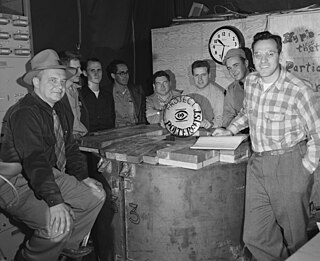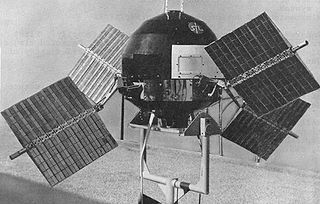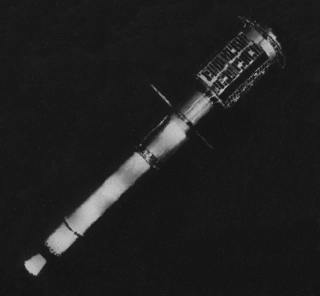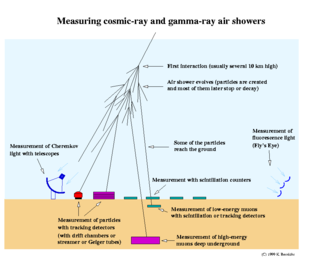
A Geiger counter is an electronic instrument used for detecting and measuring ionizing radiation. It is widely used in applications such as radiation dosimetry, radiological protection, experimental physics and the nuclear industry.

Cosmic rays or astroparticles are high-energy particles or clusters of particles that move through space at nearly the speed of light. They originate from the Sun, from outside of the Solar System in our own galaxy, and from distant galaxies. Upon impact with Earth's atmosphere, cosmic rays produce showers of secondary particles, some of which reach the surface, although the bulk are deflected off into space by the magnetosphere or the heliosphere.

Johannes Wilhelm "Hans" Geiger was a German physicist. He is best known as the co-inventor of the detector component of the Geiger counter and for the Geiger–Marsden experiment which discovered the atomic nucleus. He also carried the Bothe–Geiger coincidence experiment that confirmed the conservation of energy in light-particle interactions.

The Geiger–Müller tube or G–M tube is the sensing element of the Geiger counter instrument used for the detection of ionizing radiation. It is named after Hans Geiger, who invented the principle in 1908, and Walther Müller, who collaborated with Geiger in developing the technique further in 1928 to produce a practical tube that could detect a number of different radiation types.

A scintillation counter is an instrument for detecting and measuring ionizing radiation by using the excitation effect of incident radiation on a scintillating material, and detecting the resultant light pulses.

Walther Wilhelm Georg Bothe was a German nuclear physicist know for the development of coincidence methods to study particle physics.

Bruno Benedetto Rossi was an Italian experimental physicist. He made major contributions to particle physics and the study of cosmic rays. A 1927 graduate of the University of Bologna, he became interested in cosmic rays. To study them, he invented an improved electronic coincidence circuit, and travelled to Eritrea to conduct experiments that showed that cosmic ray intensity from the West was significantly larger than that from the East.

Neutrino astronomy is the branch of astronomy that observes astronomical objects with neutrino detectors in special observatories. Neutrinos are created as a result of certain types of radioactive decay, nuclear reactions such as those that take place in the Sun or high energy astrophysical phenomena, in nuclear reactors, or when cosmic rays hit atoms in the atmosphere. Neutrinos rarely interact with matter, meaning that it is unlikely for them to scatter along their trajectory, unlike photons. Therefore, neutrinos offer a unique opportunity to observe processes that are inaccessible to optical telescopes, such as reactions in the Sun's core. Neutrinos can also offer a very strong pointing direction compared to charged particle cosmic rays.

The Cowan–Reines neutrino experiment was conducted by physicists Clyde Cowan and Frederick Reines in 1956. The experiment confirmed the existence of neutrinos. Neutrinos, subatomic particles with no electric charge and very small mass, had been conjectured to be an essential particle in beta decay processes in the 1930s. With neither mass nor charge, such particles appeared to be impossible to detect. The experiment exploited a huge flux of electron antineutrinos emanating from a nearby nuclear reactor and a detector consisting of large tanks of water. Neutrino interactions with the protons of the water were observed, verifying the existence and basic properties of this particle for the first time.

Explorer 6, or S-2, was a NASA satellite, launched on 7 August 1959, at 14:24:20 GMT. It was a small, spheroidal satellite designed to study trapped radiation of various energies, galactic cosmic rays, geomagnetism, radio propagation in the upper atmosphere, and the flux of micrometeorites. It also tested a scanning device designed for photographing the Earth's cloud cover. On 14 August 1959, Explorer 6 took the first photos of Earth from a satellite.

The proportional counter is a type of gaseous ionization detector device used to measure particles of ionizing radiation. The key feature is its ability to measure the energy of incident radiation, by producing a detector output pulse that is proportional to the radiation energy absorbed by the detector due to an ionizing event; hence the detector's name. It is widely used where energy levels of incident radiation must be known, such as in the discrimination between alpha and beta particles, or accurate measurement of X-ray radiation dose.
A wire chamber or multi-wire proportional chamber is a type of proportional counter that detects charged particles and photons and can give positional information on their trajectory, by tracking the trails of gaseous ionization.

Explorer 11 was a NASA satellite that carried the first space-borne gamma-ray telescope. This marked the beginning of space gamma-ray astronomy. Launched on 27 April 1961 by a Juno II, the satellite returned data until 17 November 1961, when power supply problems ended the science mission. During the spacecraft's seven-month lifespan it detected twenty-two events from gamma-rays and approximately 22,000 events from cosmic radiation.

Air showers are extensive cascades of subatomic particles and ionized nuclei, produced in the atmosphere when a primary cosmic ray enters the atmosphere. When a particle of the cosmic radiation, which could be a proton, a nucleus, an electron, a photon, or (rarely) a positron, interacts with the nucleus of a molecule in the atmosphere, it produces a vast number of secondary particles, which make up the shower. In the first interactions of the cascade especially hadrons are produced and decay rapidly in the air, producing other particles and electromagnetic radiation, which are part of the shower components. Depending on the energy of the cosmic ray, the detectable size of the shower can reach several kilometers in diameter.
Electronic anticoincidence is a method widely used to suppress unwanted, "background" events in high energy physics, experimental particle physics, gamma-ray spectroscopy, gamma-ray astronomy, experimental nuclear physics, and related fields.
In quantum physics, coincidence counting is used in experiments testing particle non-locality and quantum entanglement. In these experiments two or more particles are created from the same initial packet of energy, inexorably linking/entangling their physical properties. Separate particle detectors measure the quantum states of each particle and send the resulting signal to a coincidence counter. In any experiment studying entanglement, the entangled particles are vastly outnumbered by non-entangled particles which are also detected; patternless noise that drowns out the entangled signal. In a two detector system, a coincidence counter alleviates this problem by only recording detection signals that strike both detectors simultaneously. This ensures that the data represents only entangled particles.

Survey meters in radiation protection are hand-held ionising radiation measurement instruments used to check such as personnel, equipment and the environment for radioactive contamination and ambient radiation. The hand-held survey meter is probably the most familiar radiation measuring device owing to its wide and visible use.

A cosmic-ray observatory is a scientific installation built to detect high-energy-particles coming from space called cosmic rays. This typically includes photons, electrons, protons, and some heavier nuclei, as well as antimatter particles. About 90% of cosmic rays are protons, 9% are alpha particles, and the remaining ~1% are other particles.
In particle physics, the coincidence method is an experimental design through which particle detectors register two or more simultaneous measurements of a particular event through different interaction channels. Detection can be made by sensing the primary particle and/or through the detection of secondary reaction products. Such a method is used to increase the sensitivity of an experiment to a specific particle interaction, reducing conflation with background interactions by creating more degrees of freedom by which the particle in question may interact. The first notable use of the coincidence method was conducted in 1924 by the Bothe–Geiger coincidence experiment.
In the history of quantum mechanics, the Bothe-Geiger coincidence experiment was conducted by Walther Bothe and Hans Geiger from 1924 to 1925. The experiment explored x-ray scattering from electrons to determine the nature of the conservation of energy at microscopic scales, which was contested at that time. The experiment confirmed existence of photons, the conservation of energy and the Compton scattering theory.

















